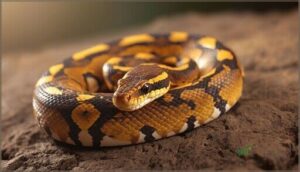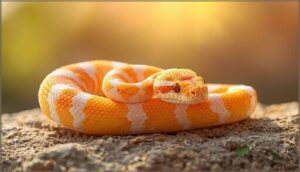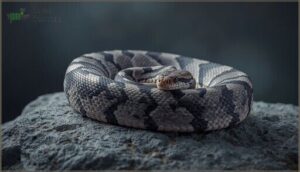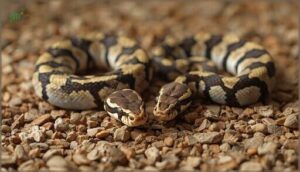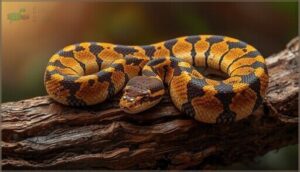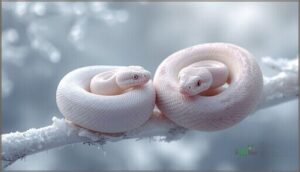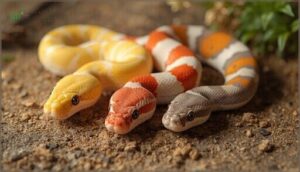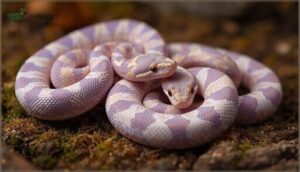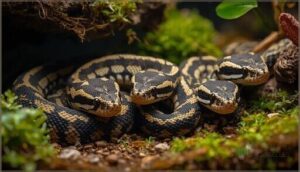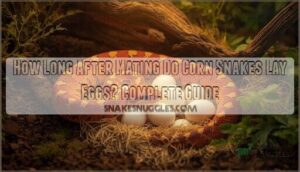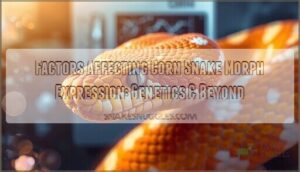This site is supported by our readers. We may earn a commission, at no cost to you, if you purchase through links.
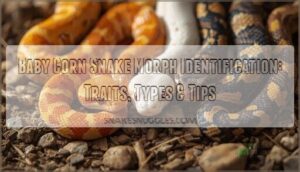 Spotting your first baby corn snake morph feels a bit like solving a puzzle with scales and color. One day you’re holding a hatchling with fire-orange stripes; the next, a ghostly white snake with ruby eyes stares up from the deli cup.
Spotting your first baby corn snake morph feels a bit like solving a puzzle with scales and color. One day you’re holding a hatchling with fire-orange stripes; the next, a ghostly white snake with ruby eyes stares up from the deli cup.
The variety isn’t random—those patterns and shades trace back to genes that quietly rewrite the rules of what a corn snake can be. Learning baby corn snake morph identification turns every hatchling into a story worth decoding, and with the right eye, you’ll catch clues most folks miss.
Ready or not, the hunt for the rare ones starts early.
Table Of Contents
Key Takeaways
- Baby corn snake morphs are identified by unique combinations of color, pattern, eye color, and scale texture, all driven by genetic mutations.
- Compound morphs, which combine multiple recessive traits, now make up over 60% of hatchlings and show much greater diversity than single morphs.
- Rare morphs like Avalanche, Palmetto, and Scaleless are hard to find due to complex genetics and breeding challenges, often commanding higher prices.
- Accurate morph identification relies on careful observation and breeder records, since lighting, age, and incomplete data can easily lead to mistakes.
What Are Baby Corn Snake Morphs?
A corn snake morph is a snake with specific color and pattern traits that differ from the wild type. These variations come from genetic mutations that breeders select and combine over generations.
Understanding how single and compound mutations work will help you identify what morph your baby corn snake actually is.
Definition of a Corn Snake Morph
A corn snake morph is a genetic variation that creates a snake with different colors or patterns than the wild-type. These inheritable traits come from specific mutations in the snake’s genes. You’ll find over 800 recognized morphs today. Selective breeding of morphs can sometimes lead to overbreeding and health problems.
Key points for morph classification:
- Morphs must pass visually to offspring
- Wild-type distinction shows clear differences
- Phenotype expression reveals unique characteristics
Most corn snake morphs you see in stores aren’t wild-type snakes.
Genetic Mutations Behind Morphs
Genetic mutations create morphs by changing specific genes that control color and pattern. These changes are evident in genes like OCA2, responsible for amelanism, or LYST, linked to lavender morphs. These traits are recessive, requiring two copies of the mutated gene to manifest in a snake. Genomic mapping assists breeders in tracking allele frequencies and predicting breeding outcomes. Gene inheritance follows clear patterns, making morph breeding a predictable process. Research indicates that the LYST mutation impacts the biogenesis of melanosomes.
| Gene | Mutation Effect | Resulting Morph |
|---|---|---|
| OCA2 | Removes melanin | Amelanistic |
| LYST | Alters pigment granules | Lavender |
| CLCN2 | Changes pattern formation | Motley/Striped |
| PMEL | Lightens color pattern | Terrazzo |
| Multiple | Combines genetic traits | Compound recessive morphs |
Overview of Single Vs. Compound Morphs
You’ll encounter two main categories when identifying corn snake morphs. Single morphs show one altered genetic trait, like amelanism or the motley pattern. Compound morphs combine multiple recessive traits through breeding strategies, creating phenotype diversity you won’t find in nature.
These genetic interactions produce thousands of possible variants. Market trends show compound morphs now make up over 60% of available hatchlings, improving identification accuracy requires understanding both types.
Key Traits for Morph Identification
Identifying a baby corn snake morph starts with observing specific physical traits. You need to look at color, eyes, patterns, and even scale texture to make an accurate match. These four traits work together like puzzle pieces to reveal what morph you’re holding.
Main Color Variations in Hatchlings
Identifying corn snake morphs starts with recognizing main colors in hatchlings. Wildtype coloration shows orange-red bases with black-bordered red saddles. Amelanistic hues display bright orange and yellow tones without black pigment. Anerythristic shades present pure blacks and grays with no red. Caramel bases feature golden-brown backgrounds. Snow patterns combine white and pink blotches.
These color variations give you your first clues when identifying corn snake morphs.
Eye Color and Its Significance
Eye color is a shortcut for morph identification. Amelanistic eyes stand out with red or pink in every albino hatchling. Palmetto irises show blue or flecked white, making them easy to spot. Lavender eyes appear ruby or reddish in most babies.
Eye development rarely shifts after hatching. Heterochromia is nearly unheard of, so one odd eye signals a rare genetic twist.
Pattern Types (motley, Striped, Tessera, Etc.)
When sorting baby corn snake patterns, look for Motley Identification—elongated blotches and no ventral checkers. Stripe Genetics show up as crisp lines running the body’s length, with solid white bellies. Tessera Inheritance stands out with a bold, unbroken stripe and retained side markings.
Pattern Diversity means you’ll see plenty of unique scale patterns, so keep Hatchling Traits in mind.
Influence of Scale Texture and Head Markings
Texture tells a story. Scaleless head patterns make morph identification tricky, since you lose typical scale patterns. Look for hatchling head markings and color patterns—these are your texture identification clues.
Scale morphology variation, especially in scaleless morphs, means you’ll rely more on head and neck color shifts.
Developmental timing trends also impact morph descriptions, so always check for changes as your corn snake grows.
Common Baby Corn Snake Morphs
Baby corn snakes come in a wide range of colors and patterns. Each morph has its own traits you can spot early on.
Here’s what you’ll see most often in hatchlings.
Amelanistic (Albino)
Ever wondered why some baby corn snakes look like living sunsets? Amelanistic, or Albino, morphs pop with vivid orange, yellow, and white. Their red eyes make identification easy, though saddle markings can vary. Albino genetics follow simple recessive rules, so you’ll see them often in commercial availability. Watch for these features:
- Bright body colors
- Red eye
- No melanin
- Pink or red saddle markings
- Common in hatchling collections
Anerythristic
Looking for a hatchling with striking gray coloration and no hint of red? Anerythristic corn snakes show the absence of erythrin, giving them a charcoal base and silver tones. These morphs are common in breeding programs and often serve as the foundation for complex morph combinations. Use clear black saddles and lack of orange as your main snake morph identification clues.
| Trait | Anerythristic Morph |
|---|---|
| Gray Coloration | Yes |
| Erythrin Absence | Yes |
| Charcoal Base | Yes |
| Breeding Frequency | High |
| Morph Combinations | Frequent |
Motley and Striped
What sets Motley and Striped corn snake morphs apart is their unique pattern disruption and clear belly markings. Motley shows circular or linked spots, while Stripe displays longitudinal lines.
Both morphs challenge identification, especially in hatchlings, due to allelic inheritance and overlapping snake morph characteristics. Accurate cornsnake morph identification depends on close attention to breeding outcomes and subtle belly pattern differences.
Tessera
If you’re sorting through corn snake morphs, Tessera stands out thanks to dominant inheritance and its pinstripe appearance. You’ll spot a clean, continuous lateral stripe with blocky saddles—no pattern breaks over the spine.
Tessera’s popularity comes from crossbreeding prevalence, so visual variations are common. When identifying Tessera, look for that sharp lateral stripe and mostly unmarked belly in hatchlings.
Snow and Blizzard
After Tessera, you’ll want to watch for Snow and Blizzard morphs. Snow genetics combine amelanistic and anerythristic alleles, giving hatchlings pale, almost white bodies. Blizzard traits stack even more compound alleles for a frosty, patternless look. Identification challenges pop up since markings fade fast. Breeding outcomes depend on recessive genes.
- Pale body color
- Minimal pattern
- Red or pink eyes
- Complex genetics
Butter, Candycane, and Miami Phase
Butter genetics give hatchlings a yellow-and-white look, making them easy to spot among common corn snake morphs. If you see bright red saddles on a white background, you’re likely looking at a Candycane—these come from careful Candycane breeding. Miami Phase babies stand out for their sharp Miami contrast, with gray bodies and bold orange saddles.
Morph popularity shifts, but these three stay favorites.
Rare and Unique Morph Combinations
Some baby corn snake morphs stand out for their rare genetics and striking looks. These combinations aren’t easy to find and often have unique traits. Here’s what you should know about the most uncommon morphs you’ll see.
Avalanche, Palmetto, and Scaleless
Ever wondered why Avalanche, Palmetto, and Scaleless corn snake morphs are so rare in the morph market?
Avalanche genetics blend four recessive traits, making hatchlings scarce. Palmetto defects like bug eyes show up in 17% of babies, mostly males. Scaleless breeding remains tricky—less than ten successful hatchlings per season.
These are the rarest combinations among snake morphs.
Bloodred and Honey
A true Bloodred corn snake morph stands out for its deep red body and nearly complete pattern absence, thanks to diffused genetics. Honey coloration is rare, making breeding challenges common. Market value for these morphs runs high, driven by:
- Intense color
- Minimal belly markings
- Rarity in listings
- Compound gene expression
- Desirable snake morph characteristics
Lavender, Lavender Ghost, and Ultramel
Lavender variations catch your eye with their burgundy, gray, or pink eye coloration. Ghost genetics add subtle pattern expression, making each hatchling unique. Ultramel hybrids strip away red pigment, leaving muted tones. Rare snake morphs like Lavender Ghost and Ultramel stand out for their unpredictable colors and markings. Baby corn snake morphs show surprising diversity at this stage.
| Morph Type | Eye Color |
|---|---|
| Lavender | Burgundy, Gray |
| Lavender Ghost | Pink, Red |
| Ultramel Hybrid | Gray, Orange |
| Snake Morphs | Variable |
Kastanie and Hybrid Morphs
A Kastanie hybrid is a rare sight in corn snake morphs. Kastanie genetics add deep mahogany or chocolate tones, while morph stacking creates unique palette variations.
Hybrid rarity drives up hybrid pricing, with fewer than 50 documented hatchlings worldwide. If you spot a Kastanie or hybrid, look for unusual snake morph descriptions and rich colors not seen in standard snake morphs.
Tips for Accurate Morph Identification
Spotting the right morph in a baby corn snake takes a careful eye and a bit of know-how. You’ll want to look beyond just color and pattern to get it right. Here’s what you should keep in mind when identifying young morphs.
Recognizing Morphs in Young Snakes
Spotting corn snake morphs in hatchlings is a bit like decoding a secret message. You’ll want to check these clues:
- Hatchling coloration changes as they mature
- Eye coloration stands out in certain morphs
- Scale texture can be smooth or rough
- Pattern clarity helps spot unique traits
- Genetic records confirm what you see
Trust your eyes, but back up with records.
Using Pattern and Color as Clues
Ever notice how color spectrum analysis and pattern contrast levels can make morphs pop or fade? You’ll want to look for symmetry pattern recognition in stripes and motleys, and use color variations to distinguish similar morphs.
Identifying faded morphs means checking for muted snake color patterns. Corn snake morphs often reveal themselves through sharp pattern and color morphs differences.
Consulting Breeder Records and Genetics
Want to know the real secret to pinpointing a baby corn snake’s morph? Dive into breeder records and genetic verification. Reliable lineage tracking and mutation identification help you spot recessive gene traits and dominant gene traits with confidence. Look for:
The best way to identify a baby corn snake’s morph is by checking breeder records and verifying its genetics
- Parent morph history
- DNA genotyping results
- Record accuracy logs
- Breeding standards compliance
Selective breeding keeps corn snake genetics clear and trustworthy.
Avoiding Common Identification Mistakes
After you’ve checked the paperwork, be careful where mistakes often creep in. Lighting effects can hide or exaggerate color changes, especially in young cornsnake morphs. Pattern overlap trips up even experienced breeders.
Hybrid confusion is common, so don’t rely on one photo. Incomplete data, like missing belly shots or unclear eye color, means you’re guessing—not truly understanding corn snake morphs.
Frequently Asked Questions (FAQs)
Are some morphs more expensive than others?
Yes, some corn snake morphs cost much more than others. Morph rarity, breeding difficulty, market demand, coloration complexity, and even gender premium all drive prices—rare corn snake morphs like Palmetto or Scaleless can sell for thousands.
How quickly do hatchling colors change as they age?
Hatchling corn snake colors shift most during their first year, especially after each shed. The color change timeline varies by morph, with pattern maturation and pigmentation deepening.
Environmental triggers play a role, so identification implications depend on morph-specific variation.
Do certain morphs require special care or diets?
Think of corn snake morphs like threads in a tapestry—each has its own care details. Albino sensitivity means less light. Scaleless humidity needs rise.
Rare morphs may have genetic predispositions, but dietary needs stay the same for all reptiles.
Which morphs are most prone to health issues?
Scaleless concerns include shedding and skin injuries. Palmetto eyes show “bug-eye” issues. Lavender kinks affect spine shape.
Cardiac morphs like Caramel and Striped risk heart problems. Amelanistic health is stable.
Recessive gene mutations drive these genetic traits.
Conclusion
It’s ironic—baby corn snake morph identification isn’t about seeing what’s obvious. The rarest traits often hide behind the plainest scales or a subtle shift in pattern. You’ll find yourself double-checking records, squinting at head markings, and second-guessing colors.
That’s the challenge and the reward. Each hatchling is a puzzle piece, and every clue brings you closer to mastery. With practice, your eyes sharpen, and the ordinary transforms into something worth noticing. That’s how you grow.
- https://www.livescience.com/44008-corn-snakes.html
- https://phys.org/news/2025-04-gene-corn-snake-skin-pattern.html
- https://www.sciencedaily.com/releases/2025/04/250424121511.htm
- https://www.reptilecentre.com/blogs/reptile-blog/5-popular-corn-snake-morphs
- https://snakeinsider.com/how-much-is-a-corn-snake/

